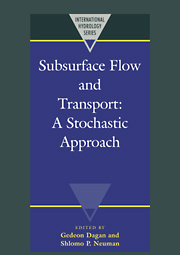Book contents
- Frontmatter
- Contents
- List of contributors
- Preface
- Acknowledgments
- I INTRODUCTION
- II SUBSURFACE CHARACTERIZATION AND PARAMETER ESTIMATION
- III FLOW MODELING AND AQUIFER MANAGEMENT
- 1 Groundwater flow in heterogeneous formations
- 2 Aspects of numerical methods in multiphase flows
- 3 Incorporating uncertainty into aquifer management models
- IV TRANSPORT IN HETEROGENEOUS AQUIFERS
- V FRACTURED ROCKS AND UNSATURATED SOILS
- VI A VIEW TO THE FUTURE
3 - Incorporating uncertainty into aquifer management models
Published online by Cambridge University Press: 04 December 2009
- Frontmatter
- Contents
- List of contributors
- Preface
- Acknowledgments
- I INTRODUCTION
- II SUBSURFACE CHARACTERIZATION AND PARAMETER ESTIMATION
- III FLOW MODELING AND AQUIFER MANAGEMENT
- 1 Groundwater flow in heterogeneous formations
- 2 Aspects of numerical methods in multiphase flows
- 3 Incorporating uncertainty into aquifer management models
- IV TRANSPORT IN HETEROGENEOUS AQUIFERS
- V FRACTURED ROCKS AND UNSATURATED SOILS
- VI A VIEW TO THE FUTURE
Summary
INTRODUCTION
The aim of aquifer simulation is to predict how hydraulic heads and solute concentrations respond to system stresses such as pumping and recharge. In many cases, simulation alone does not provide the results necessary to manage groundwater resources. What is needed is a design tool to find the best arrangement of pumping and recharge in order to control the heads and concentrations over space and time. One might want the managed head declines to be limited to some target value, or to ensure that solute concentrations never exceed water quality standards at supply wells. These controls must be maintained while achieving some objective, such as minimizing cost or risk. The recognition that simulation is not an end in itself has led to the development of aquifer management models.
During the past 30 years, the field of aquifer management modeling has developed as a distinct discipline. It has provided a framework which replaces trial and error simulations. Modern aquifer management models combine simulation tools with optimization techniques. The optimization techniques were developed in fields such as operations research and applied physics, and were adapted to unite with aquifer simulation models. This combination of formal optimization and aquifer simulation provides a framework that forces the engineer or hydrologist to formulate carefully the groundwater management problem. The problem must contain a series of constraints on heads, drawdowns, pumping rates, hydraulic gradients, groundwater velocities, and solute concentrations. In addition, an objective, usually involving costs, cost surrogates, or risk, must be stated. The power underlying this union of highly computational technologies was unleashed when computers became fast and cheap.
Information
- Type
- Chapter
- Information
- Subsurface Flow and TransportA Stochastic Approach, pp. 101 - 112Publisher: Cambridge University PressPrint publication year: 1997
Accessibility standard: Unknown
Why this information is here
This section outlines the accessibility features of this content - including support for screen readers, full keyboard navigation and high-contrast display options. This may not be relevant for you.Accessibility Information
- 12
- Cited by
